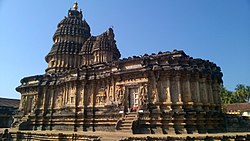Sringeri
| Sringeri ಶೃಂಗೇರಿ |
||
|---|---|---|
|
|
||
| State : |
|
|
| State : | Karnataka | |
| District : | Chikmagalur | |
| Sub-district : | Sringeri | |
| Location : | 13 ° 25 ' N , 75 ° 15' E | |
| Height : | 670 m | |
| Area : | 3.4 km² | |
| Residents : | 3,922 (2011) | |
| Population density : | 1154 inhabitants / km² | |
| Sringeri - Sri Vidyashankara Temple | ||
Sringeri or Sri Kshetra Shringeri ( Kannada ಶೃಂಗೇರಿ) is a place with approx. 4,000 inhabitants in the southern Indian state of Karnataka .
Location and climate
The small town of Sringeri is located on the Dekkan Highlands on the Tunga River about 320 km (driving distance) west of the city of Bangalore at an altitude of about 670 m ; the district capital Chikmagalur is about 85 km to the east. The climate is warm to hot; Rain (approx. 3800 mm / year) almost only falls in the summer monsoon months .
population
| year | 1991 | 2001 | 2011 |
| Residents | 4.146 | 4,249 | 3,922 |
Around 94.5% of the population are Hindus and around 5% are Muslims ; the rest is distributed among other religions ( Jains , Sikhs , Buddhists , Christians ). The proportion of female and male residents is roughly the same.
economy
The inhabitants of the small town live directly or indirectly from agriculture. Pilgrimage tourism also plays an important role.
history
Sringeri was a farming village in which a monastic community (matha) developed in the early 9th century under the leadership of Adi Shankara , the founder of the Advaita movement.
Attractions
- The Sharadamba temple is possibly the oldest temple in the place and goes back to Adi Shankara; However, it has been redesigned repeatedly and is now dedicated to the goddess Sharada Devi .
- The Vidyashankara Temple , dedicated to the Hindu god Shiva , was built around the middle of the 14th century by Vidyaranya, the spiritual leader of Harihara I and Bukka Raya I, the founders of the Vijayanagar empire. In architectural terms, the temple construction combines influences from Hoysala and Vijayanagar architecture. It consists of a vestibule ( mandapa ) accessible from three sides via staircases , an anteroom ( antarala ) and the cella ( garbhagriha ) with the lingam, which is elevated by a multi-tiered Vimana tower . The spire is framed by a ribbed ring stone ( amalaka ) , next to it there are several vases ( kalashas ) . The figurative decorations on the outer walls consist of gods and guardian figures, which, however, mostly stand individually and only rarely interact with one another.
- Surroundings
- The Sri Parshwanath Temple is a medieval Jain temple which - despite its antiquated appearance - is dated to around 1150. The pillar-supported vestibule (mandapa) is unadorned and has a flat roof, whereas the rest of the building has a stone pitched roof (added later?). It is also worth mentioning that the central figure of the Tirthankaras Parshvanata , who strangely stands on a yoni base, is crowned by a hood made from two intertwined serpent bodies.
Web links
- Sringerie, sights - photos + information (English)


